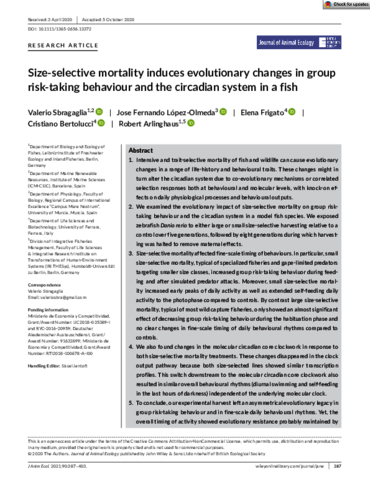1. Intensive and trait-selective mortality of fish and wildlife can cause evolutionary changes in a range of life-history and behavioural traits. These changes might in turn alter the circadian system due to co-evolutionary mechanisms or correlated selection responses both at behavioural and molecular levels, with knock-on effects on daily physiological processes and behavioural outputs.
2. We examined the evolutionary impact of size-selective mortality on group risktaking behaviour and the circadian system in a model fish species. We exposed zebrafish Danio rerio to either large or small size-selective harvesting relative to a control over five generations, followed by eight generations during which harvesting was halted to remove maternal effects.
3. Size-selective mortality affected fine-scale timing of behaviours. In particular, small size-selective mortality, typical of specialized fisheries and gape-limited predators targeting smaller size classes, increased group risk-taking behaviuor during feeding and after simulated predator attacks. Moreover, small size-selective mortality increased early peaks of daily activity as well as extended self-feeding daily activity to the photophase compared to controls. By contrast large size-selective mortality, typical of most wild capture fisheries, only showed an almost significant effect of decreasing group risk-taking behaviour during the habituation phase and no clear changes in fine-scale timing of daily behavioural rhythms compared to controls.
4. We also found changes in the molecular circadian core clockwork in response to both size-selective mortality treatments. These changes disappeared in the clock output pathway because both size-selected lines showed similar transcription profiles. This switch downstream to the molecular circadian core clockwork also resulted in similar overall behavioural rhythms (diurnal swimming and self-feeding in the last hours of darkness) independent of the underlying molecular clock.
5. To conclude, our experimental harvest left an asymmetrical evolutionary legacy in group risk-taking behaviour and in fine-scale daily behavioural rhythms. Yet, the overall timing of activity showed evolutionary resistance probably maintained by a molecular switch. Our experimental findings suggest that size selective mortality can have consequences for behaviour and physiological processes.

